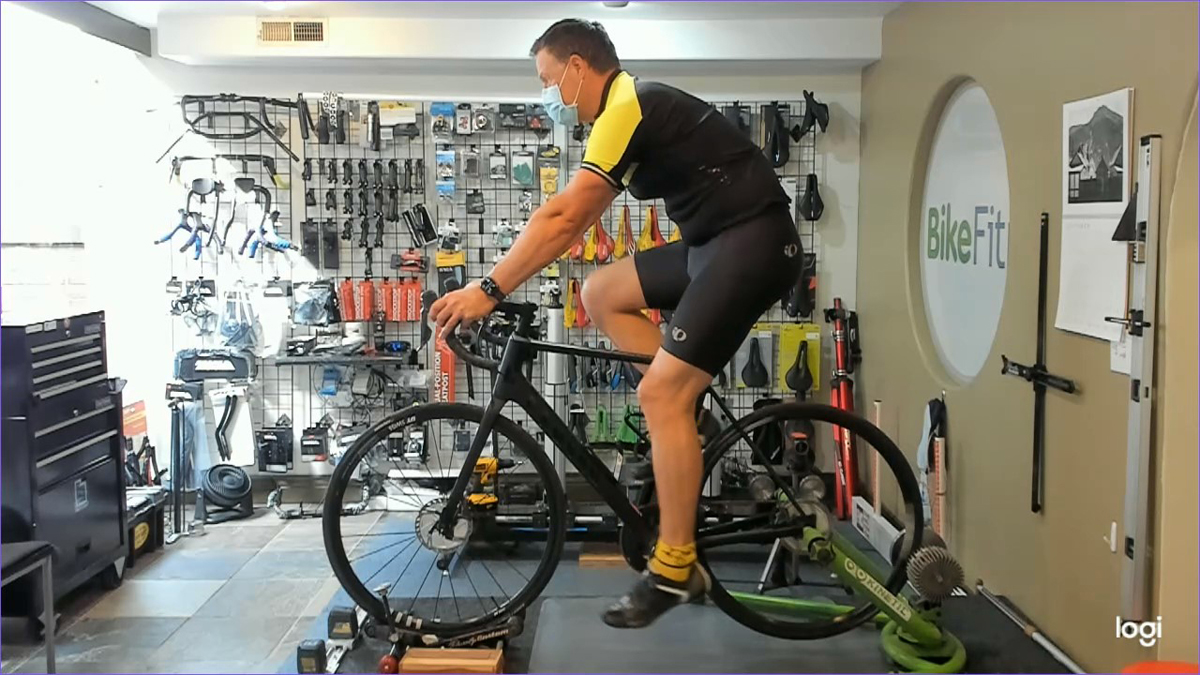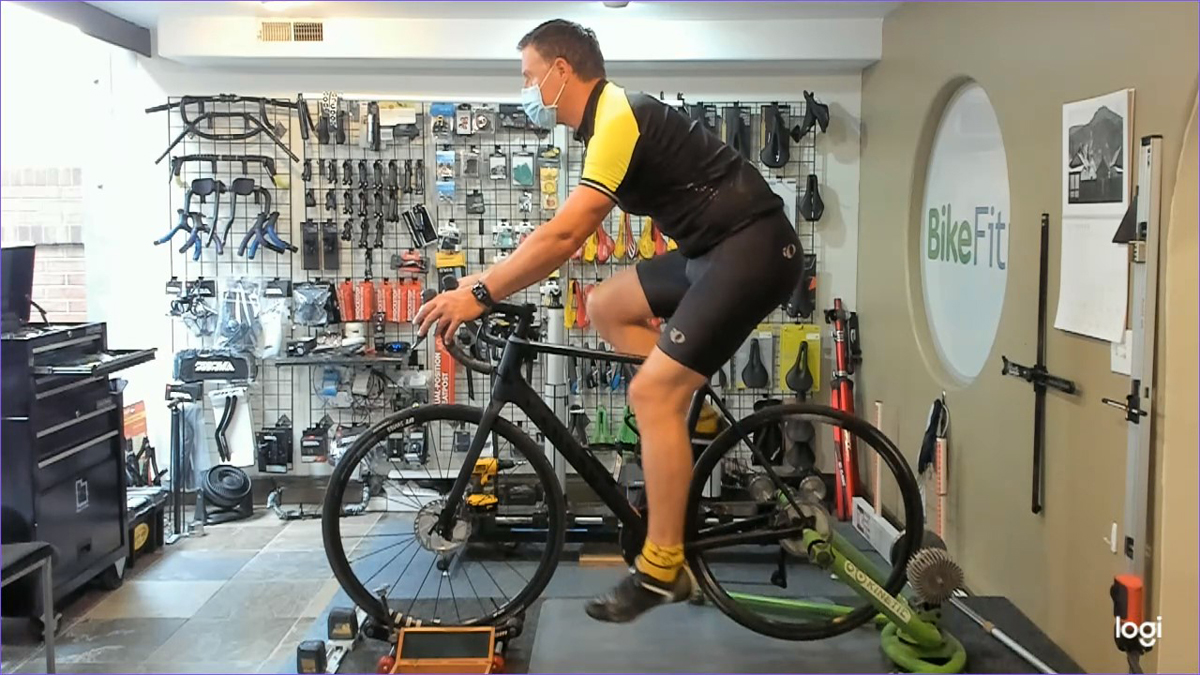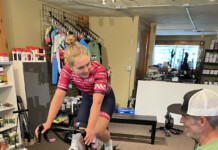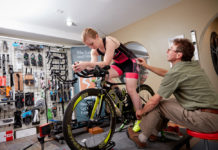By John Higgins — In the past decade, “advanced bike fitting” has been driven by a focus on the cyclist’s position, which has been enabled by digital tools like the Retul system that can dynamically measure joint angles and range of motion. Posture has often been overlooked, as it is not easily measured and quantified.
Typing “cycling posture” into a search engine yields many thousands of results. However, a perusal of the results shows significant conflation between “posture” and “position”. A clear distinction is rarely made between the two. A similar result comes from searching the biomechanical scientific literature. There are thousands of results for “cycling” + “posture” but only 8 articles for “cycling posture”. Adding “bike fit” to the search criteria yielded a scant 4 results from the past 10 years, and again posture was conflated with position.

What is “posture”
Posture is how we align and hold our body to counter the relentless force of gravity. Regardless of whether we are standing, walking, running, sleeping, or cycling, the influence of gravity is ever present. The central focus of posture is the alignment of the pelvis and spine, which together provide the foundation for the movement of the upper and lower extremities.
What is “position”
Position considers the arrangement and movement of the upper and lower limbs in relation to the spine, and each other. Body position is commonly defined by joint angle measures, and indirectly documented by bike set up measures. A cyclist may exhibit the same position as defined by joint angles, but significantly different posture with implications for metabolic efficiency, sustainable comfort, and performance.
Both posture and position interact to affect how you look on a bike, and how you function. Although position is very important, posture has a higher priority and therefore needs to be observed, assessed and corrected – as appropriate for that cyclist – before fine tuning the position.
Optimal posture in cycling involves mild lumbar and thoracic flexion with mild cervical extension. No section should be at end of range, and there should be no excessive directional changes at any segment that could result in disc compression or nerve entrapment. Indicators of suboptimal posture could include: a vertical or near vertical pelvis and lumbar angle (posterior pelvic tilt), excessive flexion in segments of the lumbar or thoracic spine (thoracic kyphosis, or hunched back), excessive extension in the cervical spine (cervical lordosis or kinked neck), rounded or hunched shoulders (protracted or elevated scapula), or a forward head position. A number of these conditions may be present concurrently.

Posture and Technique in Sports
In any athletic and sporting endeavor, the serious participant will seek and benefit from skills coaching that includes the best movement patterns and the postural training necessary to excel at their sport. From ball sports to ballet and golf to gymnastics, participants are educated, trained, and coached in how to use their bodies. How many cyclists, cycling coaches, or bike fitters place emphasis on first principles of aligning the body on the bicycle to contend with the relentless tug of gravity? In cycling the emphasis has been first and foremost on fitness: cardiovascular, muscular endurance, and strength in order to sustain force delivery to the pedals. A cycling coach may additionally offer guidance on hydration and nutrition; handling skills including cornering, climbing and descending; and race strategy. A bike fitter may be focused on improving contact point comfort to relieve aches and pains, and to prevent repetitive use injuries. Aerodynamic efficiency gets considerable attention in triathlon and for time trials. Posture gets scant attention, but awareness of postural alignment establishes the context and parameters for which all other aspects are anchored.
Contributors to Suboptimal Posture
- • Body and postural awareness on behalf of the cyclist. The vast majority of cyclists are unaware of how they look and function on a bicycle, other than the metrics provided from their cycle computer. With the exception of some high-performance programs, the culture of cycling has not embraced skills-based feedback and coaching, other than the skill of getting faster by getting fitter. Many cyclists do not know how they should be situated on a bicycle, and how to align and use their body to best effect for comfort and performance.
- • Equipment Choice. Many cyclists present with poor posture due to subconscious compensations for unsuitable equipment choices. The saddle is a frequent culprit and is a critical piece of equipment as many postural compensations result from a poorly supported pelvis. However, the list is extensive and also includes seat post setback, crank length, stem length and angle, handlebar width, and most fundamentally the underlying frame geometry and size.
- • Bike Fit Position. This refers primarily to saddle position (height, setback, angle) and handlebar position (reach and drop) that is deemed suitable for the cyclist. A person can present with a good position as defined by normative joint angles, and yet exhibit signs of suboptimal posture and suffer the consequences of that. If a fit position is determined and set up without considering posture, the rider is being locked into a position of ongoing postural compensation.
- Foot-Pedal Interface. An important subset of both equipment choice and the bike fit position is the choice of cycling shoe and related internal foot support, and external cleat position and modifications. Dysfunction in the stability of the feet on the pedals can have kinetic chain ripple effects up to the pelvis and spine.
- Pre-Existing Conditions. These include leg length differences, spinal conditions (scoliosis, spondylitis, stenosis, disc compression, fractures, and fusions), overuse injuries, and carryover effects from prior accidents or surgeries. Any of these may produce postural compensations as the body seeks the line of least resistance to operate the bicycle.
Benefits of Optimal Posture
A cyclist’s posture on a bicycle may be viewed as qualitatively optimal or suboptimal. Their posture will be either helping or hindering overall comfort and performance through the following attributes:
- Balance. A key role of optimal posture is to align the body to function and perform well in the presence of gravity. Hence, having the rider’s center of mass balanced over the primary fulcrum point of the bicycle will help optimize muscle recruitment and handling responsiveness. If the rider’s center of mass is balanced over the bike, then small postural changes can be more easily deployed for the demands of different riding situations, like climbing, sprinting, cornering and descending
- Airway and breathing. Optimal posture contributes to the maintenance of an open (vs restricted) airway to enable full use of the lungs. A sub-optimal posture will restrict the airway, limit the mobility of the ribcage, and inhibit the action of the diaphragm. Effective gas exchange is necessary to fuel the muscles to drive the pedals.
- Muscle recruitment. Postural alignment informs body position which affects muscle recruitment. We are looking for a balance of anterior and posterior muscle activity from the hips and lower limbs to drive the pedals, while minimizing unnecessary or compensatory upper body muscle recruitment.
- Neural transmission. Optimal spinal alignment minimizes the risk of nerve impingement to both the upper and lower limbs, supporting full neural activity which is needed for maximal muscle fiber recruitment and sensory feedback.
- Efficient Energy Use. The summation of the above factors will reduce the amount of energy used in maintaining postural compensations, extending the time taken to reach a state of fatigue. Poor posture likely hastens the onset of fatigue for any given fitness level.
- Ongoing Participation. For injured or older cyclists with disc compression or herniation, spondylosis, spinal stenosis, and cervical or lumbar fractures or fusions, the ability to maintain optimal posture while riding is critical to being able to continue riding pain-free and without further aggravation to their condition. What is optimal for cycling will depend on the condition and the individual.
For Cyclists
Let’s assume that posture could be considered “form”. We could debate if form follows function or if function follows form. I’ll suggest that the two are interrelated and that poor form (suboptimal posture) indicates compromised function on the bicycle. Improving your form could improve your function, and improving your function will improve your form. Do you know how good your form is? Could it be better? Ask for some input from riding friends, coach, or fitter. It is easier to identify suboptimal posture than it is to identify optimal posture. Video is a great tool for showing you both your posture and your position. Once a cyclist can see themselves riding, they are often quick to get the concept and intuitively recognize poor form from good form.
Once you can link how you look to how you feel on the bike, practice keeping your spine long and neutral by raising just off the saddle, sticking your butt back to tilt your pelvis forward, and extend gently forward with the top of your sternum, then lowering back onto the saddle. You want to set up an active athletic engagement, not a “hard to maintain” strain. If you find you then roll your hips back away from the nose of the saddle for more comfort, it maybe time for a different saddle. Pelvic support and comfort are critical to aligning your spine, engaging your core, and supporting your lower back.
Aches, pains, numbness and fidgeting around can indicator that your form and function could be improved. This begins with awareness of your current posture, techniques to bring mindful intent to your posture, possibly equipment changes to support good posture, and maybe changes to the saddle and handlebar position to fine tune the riding position. There is more skill to riding a bike than you think. Better skills = better riding!
[Note: This article is an edited extract from a paper presented to the International Bike Fitting Institute in 2020, to complete a mentorship program and as a requirement for additional professional recognition.]







![Cycling and Achilles Tendon Pain The muscles of the anterior compartment of the lower leg are generally responsible for dorsiflexion, and the muscles of the posterior compartment of the lower leg are generally responsible for plantar flexion. The lateral and medial muscles in both compartments invert, evert, and rotate the foot. By OpenStax College (https://cnx.org/contents/FPtK1zmh@8.108:y9_gDy74@5) [CC BY 3.0 (https://creativecommons.org/licenses/by/3.0)], via Wikimedia Commons Download for free at http://cnx.org/contents/14fb4ad7-39a1-4eee-ab6e-3ef2482e3e22@8.108](https://www.cyclingwest.com/cms/wp-content/uploads/2014/05/1123_Muscles_of_the_Leg_that_Move_the_Foot_and_Toes_b-100x70.png)
[…] suggest: “Optimal posture in cycling involves mild lumbar and thoracic flexion with mild cervical extension. No section should be at the […]
Comments are closed.